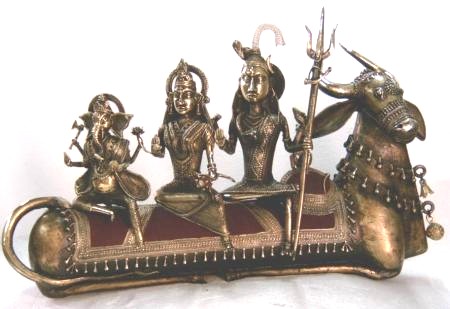Dhokra meaning “oldest” is an ancient folk craft. Some say it originated at the time of the Sumarian Culture in 2000 BC at the Indus Valley. Indeed many an expert see in it traces of pre-metal works in bamboo and cane. Today, practised by artisans who live in the vicinity of the Vindhyas and the Eastern Ghats, in and around Bihar, Orissa, Madhya Pradesh and West Bengal, these crafts continue to represent the culture, belief and tradition of their remarkable craftsmen and the place they call home. Called by different names depending on the region that they move around in, these artisans, be it the Dhokras, Ghantrars or the Ghoruas have for countless years created fascinating metalwork using the “Lost wax process ( Cire – perdue )”. Their way of life has been a difficult one, for they represent a section of the community with no land and no steady income. Leading a nomadic life, their craft has been the most enduring aspect of their existence. Slight changes depending on the location notwithstanding, their creations share a more or less similar birthing process.
Initially fine sand and clay is used to make the basic mould.The process called core building varies from place to place only in the type of materials used. Some add goat-dung others cow-dung or husk etc to the clay, the principal material. The wax preparation thereafter involves the use of pure bee-wax. Found in abundance in the jungle terrain where these craftsmen reside, the bee-wax is melted over an open fire and strained through a fine cloth into a basin of water. This ensuing wax is kept absolutely clean and free of impurities. The wax thread, its thickness depending on the wish of the workman is then prepared from this.
The thread is then wound around the clay mould until its entire surface is covered and uniformity is given to the wax cover. Lastly, the decorative aspects are added.
Channel building,
the third step, entails the adding of wax channels or runners to the finished wax figure. These at the time of baking in the furnace act as a freeway for the molten metal.
Next the entire model is covered with a thin layer of fine clay and this is in turn is followed by a thicker coating of clay, sand and cow-dung mixture.Only the tips of the wax channel are left uncovered in this, the Covering the wax stage.
This is followed by Crucible channeling, when clay pipes, which connect the crucible to the wax channel are created.
Crucible Filling – Keeping in mind the ratio of 1:10 i.e. one wax for every ten metal,broken and discarded metal scrapes are placed in the clay crucible.The crucible is then attached to the model.Thus the model and crucible form a single unit at the time of firing.
The type of Furnace utilized varies according to the place of origin of the artisan. In West Bengal this is build above the ground with bricks, and the fuel is charged from the walls to the center. The nature of fuel too differs from wood (green & dry) to charcoal to cow-dung cake and coal etc. Natural drafts and winnowing fans are used to keep the furnace blazing. The wax gets burnt in the furnace leaving a free channel for the metal. The moulds are taken out after the metal has melted and placed vertically to allow the liquefied metal to flow out of the crucible into the model. Half an hour after the moulds have been removed water is sprinkled over them to cool them further. They are then broken and the cast figures are removed.
The portions that have not come out appropriate are then retouched (finishing) and the objects are meticulously scoured at the river with clean sand to give the products a soft polished look.
Statues representing Gods and Goddesses, figures of animals, vases and in these modern times
photo-frames, door handles etc. are all a part of these craftsmen’ portfolio. Belonging to that rare
breed of items that assume the role of artifacts with the passage of time, the Dhokra crafts have the potential to become a collector’s passion.
However this craft, now shackled by lack of patronage needs to “orient itself to the changing environment……
Initially fine sand and clay is used to make the basic mould.The process called core building varies from place to place only in the type of materials used. Some add goat-dung others cow-dung or husk etc to the clay, the principal material. The wax preparation thereafter involves the use of pure bee-wax. Found in abundance in the jungle terrain where these craftsmen reside, the bee-wax is melted over an open fire and strained through a fine cloth into a basin of water. This ensuing wax is kept absolutely clean and free of impurities. The wax thread, its thickness depending on the wish of the workman is then prepared from this.
The thread is then wound around the clay mould until its entire surface is covered and uniformity is given to the wax cover. Lastly, the decorative aspects are added.
Channel building,
the third step, entails the adding of wax channels or runners to the finished wax figure. These at the time of baking in the furnace act as a freeway for the molten metal.
Next the entire model is covered with a thin layer of fine clay and this is in turn is followed by a thicker coating of clay, sand and cow-dung mixture.Only the tips of the wax channel are left uncovered in this, the Covering the wax stage.





